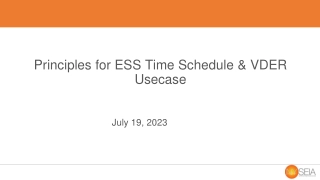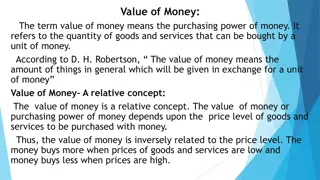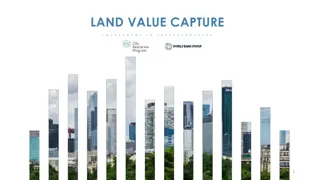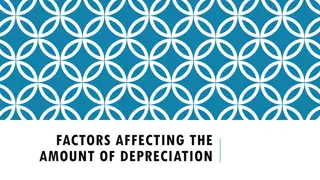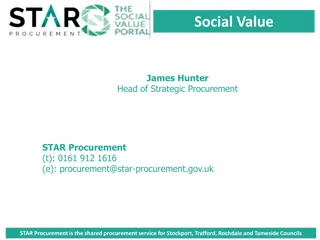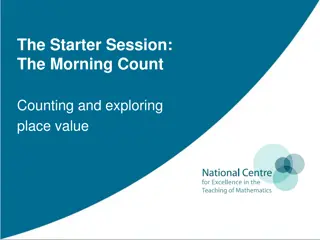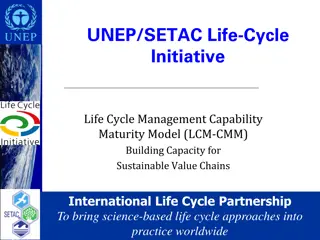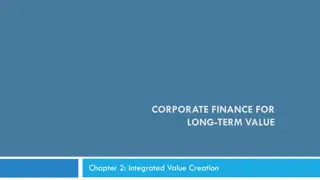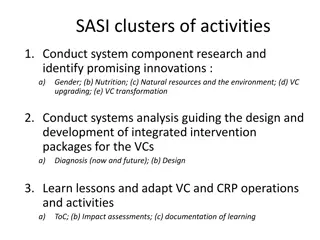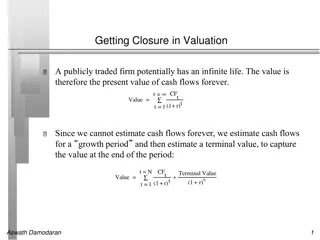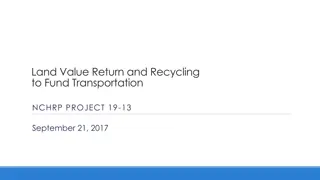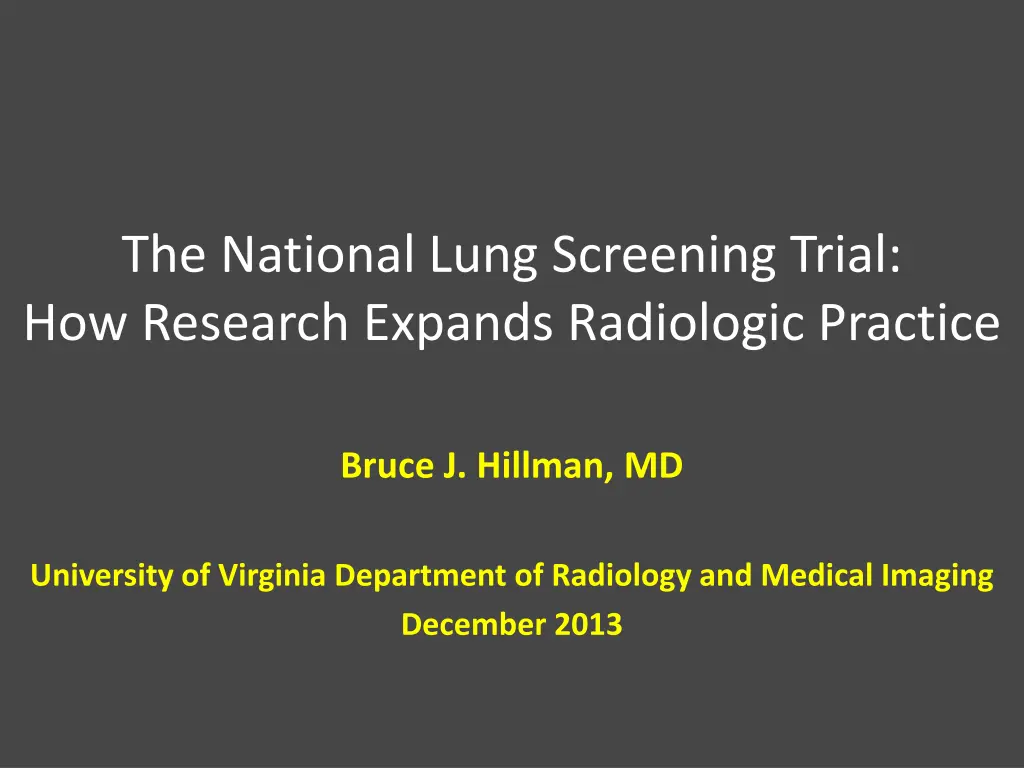
Understanding The National Lung Screening Trial and Its Impact on Radiologic Practice
Delve into the significance of The National Lung Screening Trial (NLST) in expanding radiologic practice, discussing research methodologies, screening basics, factors promoting imaging screening, and the complexities involved. Learn about the evolution of screening practices in the realm of healthcare.
Download Presentation

Please find below an Image/Link to download the presentation.
The content on the website is provided AS IS for your information and personal use only. It may not be sold, licensed, or shared on other websites without obtaining consent from the author. If you encounter any issues during the download, it is possible that the publisher has removed the file from their server.
You are allowed to download the files provided on this website for personal or commercial use, subject to the condition that they are used lawfully. All files are the property of their respective owners.
The content on the website is provided AS IS for your information and personal use only. It may not be sold, licensed, or shared on other websites without obtaining consent from the author.
E N D
Presentation Transcript
The National Lung Screening Trial: How Research Expands Radiologic Practice Bruce J. Hillman, MD University of Virginia Department of Radiology and Medical Imaging December 2013
My thanks to Dr. Denise Aberle, Professor of Radiology, University of California Los Angeles, for her many insights as Principal Investigator of the NLST and for her collaboration in writing the manuscript* on which much of this lecture is based. http://www.european-hospital.com/media/article/9774/image.jpg *Aberle and Hillman, International Day of Radiology, 2013, http://www.internationaldayofradiology.com/pu blications/. Pp. 65-84.
Research to Practice The basics of screening Observational studies of lung cancer screening The National Lung Screening Trial Why a randomized controlled trial? The process and outcomes What the NLST means to stakeholders Research and clinical practice
Definition of Screening Systematic population-based testing of individuals who are asymptomatic with respect to some target disease Prevent, interrupt, or delay the development of advanced disease in individuals with a pre-clinical form of the target condition Treatment for early disease must have better outcome than for later disease Benefit to the population must outweigh the harm - Methods Task Force of the ACR Committee on Screening Technologies
Factors Promoting Imaging Screening Makes sense to catch disease early Public demand 87% say screening always good* Public fear of key target conditions Patients growing involvement in health care Direct-to-patient advertising The Internet Striking anecdotes of screening success and positive media reports Well publicized observational research reporting benefit http://media.npr.org/programs/atc/features/2004/jan/smoking/peter140-d9f6b18585475e2887d904e7d0c3514f9f39271a-s6-c30.jpg The doc says he got it all - Anonymous and ubiquitous *Schwartz, JAMA 2004
Screening is More Complicated Three things can happen when you pass the football and two of them are bad http://www.barewalls.com/i/c/455302_Vintage-Princeton-Football.jpg - Woody Hayes
Outcomes of Imaging Screening True Negative The individual is healthy and reassured Improved quality of life Benefit outweighs cost
Outcomes of Imaging Screening False Negative Incorrect assurance that a person with disease is healthy False security May ignore later signs and symptoms Later diagnosis and treatment Cost without benefit
Outcomes of Imaging Screening False Positive imaging identifies disease that does not exist Follow-on diagnostic and therapeutic procedures Inappropriate treatments Associated morbidity, mortality, and cost Screening, Dx, Rx is all cost; no benefit Depending on the application: - Individual or society pays screening costs - Follow-on costs fall to society
Outcomes of Imaging Screening True Positive The individual has a finding that truly represents disease Disease found earlier than if symptomatic and individual incurs less morbidity/mortality Benefit outweighs cost
TPs that Produce no Benefit Disease found earlier but no impact on health outcome Incidentalomas Pseudodisease (Overdiagnosis) I: Slow growing disease II: The patient dies of some other cause III: Fast growing disease the patient dies at the same time as he would if he had not undergone screening Screening, Dx, Rx is all cost; no benefit
Lung Cancer as a Target for Screening Most common cause (27%) of U.S. cancer death in both men and women Identifiable high-risk population Potentially amenable to early stage imaging detection Up to 70% five year survival with surgical resection Treatment at an early stage more effective than treatment at advanced stages High sensitivity imaging screening test (CT) widely available
1960-1980 Screening Studies Four RCTs employing CxR and/or sputum cytology _________________ Increased survival* BUT No decrease in the death rate (mortality) *Survival = average time from diagnosis to death Mortality rate = deaths/thousand/year
1995-2002 Single Arm Studies of CT Variety in: Eligibility by risk Imaging protocols Threshold size to be considered positive Results - 3X nodule detection and more early stage cancers by CT vs. historical controls but no change in the number of late stage cancers Pseudodisease Extended survival but mortality rate not testable
Biases of Survival as Screening Endpoint http://www.intuitiveheart.com/images/visionfig4.jpg All biases systematically make screening appear to work better than it actually does Lead time bias Length bias Overdiagnosis Optimism is the madness of insisting that all is well when we are miserable - Voltaire
Lead Time Bias onset death signs/symptoms survival pre-clinical disease screen (+)
Length Bias Rapidly Progressive Disease screen onset death Indolent Disease
Early Lung Cancer Action Project International registry - Cases submitted by participating institutions Led by Claudia Henschke, MD Funded by grants from NCI, industry (GE), and tobacco companies 1999: Lancet article first of a number of I-ELCAP publications showing lengthened survival; Modeled an 80% mortality benefit Projected $6,000 per year of life saved Other modeling unable to show similar outcomes* * e.g. Bach, JAMA, 2003
ACRIN and the NLST Need for a trial with endpoint = change in mortality Randomized controlled trial Lung cancer rare even in a high risk population Large sample size Sizable number of sites Accomplished research team with varied expertise Organizational and IT infrastructure to handle massive amounts of data __________________ Very Expensive!
Serendipity 1999 NCI intramural Lung Screening Study (LSS) showed proof of concept March 2001 ACRIN proposal for 7,000 subject study and LSS for 12,000 subjects presented to NCI Board of Scientific Advisors What the organizations could afford Both studies underpowered to show a reasonably expected mortality benefit _______________ BSA: Do it right or do nothing at all!
Shotgun Wedding November 2001 - BSA approved a joint ACRIN/LSS trial of 50,000 subjects powered for 18% mortality reduction Expected cost: $200 million Early stopping rules for strongly negative/positive results Harmonized imaging, interpretation, and follow-up ACRIN to additionally gather data on: Cost Effect on smoking cessation Quality of life Specimen (blood, sputum, urine) archive on 10,000 subjects for future biomarker research
The Principals NLST Executive Committee co-chaired by ACRIN PI: Denise Aberle, MD LSS PI: John Gohagen, PhD; later Christine Berg, PhD 32 accrual sites A cadre of expert physicians, physicists, economists, sociometricians A dedicated organizational and technical infrastructure NCI Oversight Committee chaired by BSA Chair, Robert Young, MD Regular meetings and reporting to NCI Director
NLST Protocol The Basics Eligibility: Asymptomatic for lung cancer 55-74 years of age >30 pack years smoking history Still smoking or quit< 15 years previously Randomization on accrual to: 3 years annual CT and 7 years follow-up; or 3 years annual CxR and 7 years follow-up Positive scan: non-calcified nodule of 4mm or more
Why Chest Radiography as the Control? Previous trials had shown no benefit BUT Many physicians still ordering annual CxR for smokers AND Concerns that potential subjects might decline to participate if offered nothing AND Powerful pro-screening interests attacking the trial as unnecessary and unethical
Politics Henschke claimed that I-ELCAP had proven the value of screening NLST unethical The Lung Cancer Alliance, unsuccessfully petitioned to stop the trial: NIH Director, Elias Zerhouni NCI Director, Andrew von Eschenbach Anonymous tip accusing ACRIN PI of bias based on court testimony on behalf of tobacco interests Congressional investigation but no sanctions
The Outcomes 53,454 subjects enrolled in 18 months Trial closed 4 months ahead of schedule Gender and ethnic distribution similar to US smokers >90% of subjects with nodules received f/u care 24.2% of CTs (39% on initial screen) 6.9% of CXRs CT vs CxR 2X Stage 1A cancers 1/3 the number of interval cancers Fewer Stage 4 cancers ___________________ 20% lung cancer-specific mortality reduction 6.7% all causes mortality reduction
The Denouement 2011 Primary result of NLST published in NEJM 2011-2013 Imaging providers plan for and some initiate lung cancer screening programs Lahey Clinic experiments with free screening* *Wald, JACR, 2013
The Denouement 2004 U.S. Preventative Services Task Force denies the value of CT lung cancer screening based on single-arm trials August 2013 Based on NLST, USPTF categorizes CT lung cancer screening as a grade B technology Insurers to pay for the screening exam* Applicable to: 55-74 years old >30 pack years smoking Still smoking or quit within the last 15 years *PPACA mandates CMS and private payers pay for USPSTF grades A and B procedures without cost sharing
Key Concerns for Future Research False positives Improve risk stratification Change definition of positive to 5mm Watchful waiting on less concerning nodules Pseudodisease Molecular methods to better determine which lesions need treatment Value and cost of a national screening program Cost-effectiveness analysis due soon Tens of billions of dollars in added public and private costs
Ad Astra per Aspira http://t1.gstatic.com/images?q=tbn:ANd9GcT43Il488tFQ-TNOi_-oT_1DRFKZ4RG7YBsLhLL877s3ED5uDtp4g 11 years from conceptualization to publication Secondary aims published over time @ $250 million Difficulties overcome Scientific Ethical Political Financial Students achieving Oneness will move on to Twoness - Woody Allen
Ad Astra per Aspira The ups and downs of a lifetime but worth it! The winners Asymptomatic individuals at high risk for lung cancer ACRIN NIH and NCI The leaders of the trial Radiologists Expansion of clinical services Screening plus downstream imaging Opportunity to collaborate with pulmonologists and surgeons to develop and operate a CT lung cancer screening service Validation of radiology as an intellectually legitimate and inquiring specialty based on evidence development
The NLST as Metaphor Typifies how research has advanced radiologic practice over the past four decades Dramatic imaging innovations paired with IT and connectivity technologies US CT MRI PET Image-guided interventions Continuous improvement in temporal, spatial, and contrast resolution leading to new clinical capabilities
Additional Recent Examples National Oncologic PET Registry (NOPR) Collaboration with CMS under coverage with evidence development (CED) program Sponsored by a coalition of societies Administered by ACRIN Therapeutic impact of PET interpretation on cancer care PET interpretation changed a third of treatment plans _________________ Broad expansion of PET coverage for nearly all cancers and applications
Additional Recent Examples Digital Mammographic Imaging Screening Trial (DMIST) ACRIN screening trial 50,000 women with paired film-screen and full-field digital mammography FFDM equivalent overall and superior for: Dense breasts Peri-menopausal women ______________ FDA down-classification of FFDM CMS decision to pay extra for FFDM Nearly complete U.S. replacement of FS with FFDM
Additional Recent Examples National CT Colonography Trial ACRIN screening trial CTC equivalent to colonoscopy ________________ CMS denied initial submission (2010) for coverage Sample not representative of Medicare enrollees Additional analysis ongoing
The Value of Research to Practice science_square_2 The 40-year transition of radiology from a medical backwater to a premier specialty is almost entirely attributable to continuous innovation The engine of innovation is research Radiologists future success depends on continued research leading to important innovation The scientist does not study nature because it is useful. He studies it because he delights in it, and he delights in it because it is beautiful - Henri Poincare
The Challenges to Research The next decade presents critical challenges An antagonistic environment bent on cost-reduction Industry leery of investing in developing new products Declining grant moneys Tightening academic department budgets The folding of ACRIN into ECOG-ACRIN
The Challenges to Research Rank and file radiologists views about the value of research Consistently rated among the least valued of all ACR activities in ACR member surveys Research is the funny old uncle of radiology who the family mostly keeps hidden. We trot him out for family reunions and sit him in a corner where people can stop by and visit if they want - Charles Putman, MD
The Challenges to Research Commonly heard biases: Researchers don t work as hard as clinicians When researchers must access equipment after hours or its grants submission time, work hours are longer and harder Researchers work is less stressful Stressful? try to keep your grants going with falling federal funding and your livelihood on the line Researchers get paid too much for what they do Consider the demand for trained, potentially fundable researchers in elite academic departments, industry, and on Wall Street Too much of clinician-generated revenue is used to support researchers Every department needs to decide whether it wishes to be in the game it costs departments 25 cents for every extramural dollar I don t get any benefit from what they do Enhanced reputation from research achievement is essential to compete for outstanding new faculty, fellows, and residents
But Most of All If all the biases were true, why wouldn t everybody choose to be a researcher?
Research is a Good of the Specialty http://presetpond.com/uploads/570/NuclearWinter_002.jpg Individuals and organizations must spread recognition that without research leading to innovation, the specialty will enter a nuclear winter that it will not long survive Riches do not so much exhilarate us by their possession as they torment us with their loss - Epicurus
Research is a Good of the Specialty Recast research as economics and government relations with the understanding that no successes in these areas are possible without the supporting data from research http://biblescripture.net/God.jpeg In God we trust. All others bring data
Research is a Good of the Specialty All radiologists should: Recognize, appreciate, and support research Realize that both excellent clinicians and competitive researchers are essential to a successful department Bow their necks, get to work, and stop carping Learn to critically read the research literature Teach others Mentor young researchers Attend research sessions at major meetings Participate in multi-center clinical trials trial ECOG-ACRIN Industry Contribute 1% of income to an organizational research fund* * William Thorwarth, Private practice radiologist; RSNA Board of Directors; ACR Past President
Everyone has talent. What is rare is the courage to follow that talent to the dark places where it leads - Erica Jong

